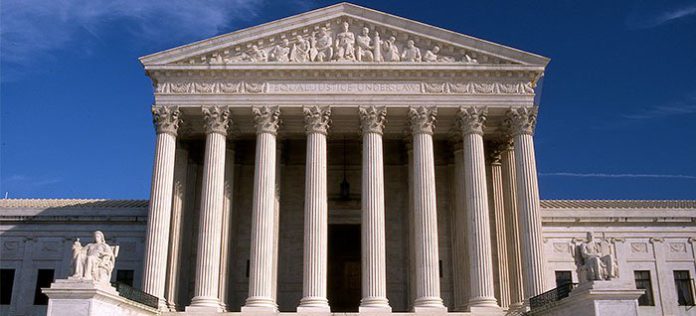
One of this year’s most-watched patent cases held oral arguments at the U.S. Supreme Court. Depending on how broadly the court rules, the outcome could have a major impact on global businesses and patent owners.
The Supreme Court heard arguments April 16 in WesternGeco v. ION Geophysical Corporation, a dispute over oil drilling technology patents that culminated in a nearly $100 million jury award for lost profits stemming from infringement.
Those lost profits, however, were earned outside the U.S. through contracts using the infringing products, and the Federal Circuit Court of Appeals held that WesternGeco wasn’t entitled to those profits under 35 U.S.C. §271(f).
The Supreme Court could issue a ruling that could give companies the wherewithal to seek patent infringement damages overseas in certain situations.
35 U.S. Code § 271(f) prohibited the practice of producing parts of another’s patented invention and sending them outside the U.S. with the intent that they be assembled for a purpose that would infringe on the patent.
That amendment, which Congress enacted in 1984, closed a loophole that was exposed in the Supreme Court’s 1972 decision Deepsouth Packing Co. v. Laitram Corp. Another part of the statute, Section 271(a), didn’t cover the export of components as an infringing act if they weren’t first assembled in the U.S., the court held.
WesternGeco is a company that manufactures and uses a device that surveys the ocean floor for oil and gas drilling sites. ION manufactured a device that WesternGeco claimed infringed on five of its patents, but instead of using the device itself, ION sold it to surveying companies.
A federal jury found ION’s infringement to be subjectively reckless and awarded WesternGeco $12.5 million in reasonable royalties and $93.4 million in lost profits.
The lost profits amount came from the contracts that WesternGeco would have won but for the foreign companies who, using ION’s infringing device, won the contracts instead, as the jury found.
ION appealed, and the Federal Circuit Court of Appeals reversed the award, saying that WesternGeco can’t recover lost profits for foreign uses of its patented device under U.S. patent law.
The WesternGeco-ION scenario — where a company manufactures components and exports them with the intent they be used for activity that would infringe on a patent — is a rare one. But the court could decide that the damages provision of U.S.C. 35 § 285 could have extraterritorial reach, which could vastly increase the legal exposure of companies that do business globally.
Some justices on the court showed reluctance in doing that, however. Justice Stephen Breyer spoke his concerns about the international implications, and “the chaos that would ensue” if 10 or more countries had laws with extraterritorial damages like WesternGeco proposes, and parts of a patented device were manufactured in those countries and sent to the U.S. for assembly.
Breyer offered up proximate cause as the limiting principle — that is, the patent owner can recover the foreign lost profits, but only if it can show it would have earned that money but for the infringing activity abroad.
Justice Neil Gorsuch expressed skepticism to the WesternGeco lawyer’s argument that his client was entitled to the lost profits. “But you don’t have a — a monopoly, a lawful monopoly, to use this technology abroad. That doesn’t belong to you. That’s outside the patent laws. And so why would you get lost profits by — because of a third party’s use entirely abroad?” Gorsuch asked.
WesternGeco’s lawyer’s reply was that his client wasn’t seeking damages for the assembly of the infringing device — which was built overseas — but for the “foreseeable consequences” of ION’s manufacture and export from U.S. soil. In this case, the foreseeable consequences were that foreign companies would use the device to win business that WesternGeco would have otherwise, according to WesternGeco.
Richard Marsh, a partner in Faegre Baker Daniels’ Denver office who practices patent law, said there’s a general sense that the Supreme Court is looking to reverse the Federal Circuit.
The court is known for applying a more generalist view to patent issues and looks less favorably on interpretations of law that seem to apply only to patents. “One of the more compelling arguments for reversal … is the damages aspect doesn’t have a stop at the border for normal torts,” Marsh said.
“What’s open for debate here is how far they’re going to go” in making foreign lost profits recoverable under patent law, Marsh said.
The court could issue a decision that declares lost profits outside the U.S. are available subject to proximate cause, and then explain what that means in the patent context.
If that happens, Marsh said, American companies might have to reconsider how they structure some international business deals so that if a party sues them for infringement, they can argue that any foreign damages are beyond the scope of what proximate cause would entail.
Proximate cause, however, is notoriously difficult to prove and would be no less challenging in a patent infringement damages context, Marsh said. But having foreign lost profits on the table in a patent dispute can up the pressure for settlement.
The additional potential damages can create that much more leverage for patent owners in negotiations, Marsh said. But the implications wouldn’t end there.
“If foreign sales are now available for damages, then that opens up new avenues for discovery,” Marsh said, and that would become “a major pain” for litigants.
— Doug Chartier

